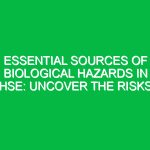In the ever-evolving landscape of Health, Safety, and Environment (HSE), Personal Protective Equipment (PPE) plays a critical role in safeguarding the well-being of employees across various industries. Understanding who is responsible for buying PPE is not just a procedural question; it is a fundamental aspect of ensuring Workplace Safety and compliance with Regulations. This article delves into the responsibilities surrounding PPE procurement, the stakeholders involved, and the importance of proper PPE selection in the HSE context.
Understanding PPE and Its Importance
PPE encompasses a wide range of protective gear designed to minimize exposure to Hazards that could cause serious injury or illness. This includes items such as helmets, gloves, masks, goggles, and Safety boots, among others. The responsibility for ensuring that appropriate PPE is available and used correctly extends beyond individual employees; it involves multiple parties within an organization.
The relevance of PPE in HSE cannot be overstated, as it serves as the last line of defense against workplace Hazards. For instance, consider a construction site where workers are exposed to falling objects. Without hard hats, the risk of head injuries increases significantly. Therefore, understanding who is responsible for buying PPE is essential for mitigating such risks and ensuring a safe working environment.
Identifying Key Stakeholders in PPE Procurement
Determining who is responsible for buying PPE involves recognizing various stakeholders within an organization. Each plays a crucial role in the procurement process, contributing to a culture of Safety and compliance.
1. Management and Leadership
At the top of the hierarchy, management and leadership are ultimately responsible for the procurement of PPE. They set the tone for safety culture by allocating budgets, establishing policies, and ensuring that the organization adheres to relevant regulations. Their decisions directly influence the quality and quantity of PPE available to employees.
2. Safety Officers and HSE Professionals
Safety officers and HSE professionals are tasked with assessing workplace hazards and determining the necessary PPE. They conduct risk assessments, evaluate existing Safety Measures, and recommend appropriate equipment. Their expertise ensures that the PPE procured aligns with the specific risks present in the workplace.
3. Procurement Department
The procurement department plays a vital role in the actual buying of PPE. They are responsible for sourcing suppliers, negotiating contracts, and managing inventory. Effective communication between the procurement team and safety professionals is essential to ensure that the right products are purchased and available when needed.
4. Employees
Employees also have a role in the PPE procurement process. Their input can provide valuable insights into the effectiveness and comfort of the equipment. Additionally, employees must be trained on the proper use and Maintenance of PPE to ensure that it provides adequate protection. This collaborative approach fosters a sense of ownership and responsibility among workers.
The Process of PPE Procurement
The process of procuring PPE involves several key steps, each of which is crucial for ensuring that the equipment meets safety Standards and adequately protects employees.
1. Hazard Assessment
The first step in the PPE procurement process is conducting a thorough hazard assessment. This involves identifying potential risks associated with specific tasks or environments. For instance, in a laboratory setting, the hazards might include chemical exposure, requiring specific gloves and goggles. A well-conducted hazard assessment informs the selection of appropriate PPE.
2. Selection of PPE
Once hazards are identified, the next step is selecting the appropriate PPE. Factors to consider include the type of hazard, the duration of exposure, and the comfort of the equipment. For example, if employees are required to work in hot conditions, selecting lightweight and breathable materials is essential for comfort and effectiveness.
3. Budgeting and Approval
After selecting the necessary PPE, the procurement team must prepare a budget. This budget should reflect the costs of purchasing high-quality PPE while considering ongoing maintenance and replacement costs. Management must approve this budget before any purchases can be made.
4. Sourcing Suppliers
With a budget in place, the procurement team can begin sourcing suppliers. It’s crucial to choose reputable vendors who provide PPE that meets safety standards. Many organizations prefer suppliers who offer a range of products, enabling them to obtain all necessary equipment from a single source.
5. Training and Implementation
Once PPE is procured, proper Training is essential. Employees should be educated on how to use, maintain, and store their PPE. This training not only enhances safety but also ensures compliance with regulations. Regular refresher courses can help maintain awareness and compliance over time.
Regulations and Standards Governing PPE Procurement
PPE procurement is governed by various regulations and standards designed to protect workers. Understanding these regulations is vital for compliance and ensuring that organizations are held accountable for employee safety.
1. Occupational Safety and Health Administration (OSHA)
In the United States, the Occupational Safety and Health Administration (osha) sets forth regulations concerning PPE. According to OSHA standards, employers are required to assess workplace hazards and provide appropriate PPE at no cost to employees. Failure to comply can result in serious penalties.
2. European Union Regulations
In the European Union, the Personal Protective Equipment Regulation (EU) 2016/425 outlines the responsibilities of employers regarding PPE. This regulation mandates that all PPE must be CE marked, indicating compliance with safety standards. Employers must ensure that PPE is suitable for the risks, provides adequate protection, and is maintained properly.
3. Industry-Specific Regulations
Different industries may have specific regulations that govern the procurement of PPE. For example, construction sites must adhere to regulations set forth by the Construction (Design and Management) Regulations, which outline specific PPE requirements based on the tasks being performed. Understanding these industry standards is crucial for compliance.
Best Practices for PPE Procurement
To effectively manage the procurement of PPE, organizations should consider implementing Best Practices that promote safety and compliance.
1. Regular Review of PPE Needs
Regularly reviewing PPE needs ensures that equipment remains relevant and effective. As workplace conditions change, so do the hazards. Conducting annual or biannual assessments can help identify new risks and determine whether existing PPE is still adequate.
2. Employee Involvement
Engaging employees in the PPE procurement process fosters a culture of safety. By soliciting feedback on the comfort and usability of PPE, organizations can make informed choices that enhance employee compliance and satisfaction. Employees who feel their voices are heard are more likely to adhere to safety protocols.
3. Supplier Relationship Management
Developing strong relationships with PPE suppliers can lead to better pricing, quality assurance, and timely deliveries. Regular communication with suppliers can also help organizations stay informed about new products and emerging safety technologies.
4. Documentation and Record Keeping
Maintaining thorough documentation of PPE purchases, training sessions, and hazard assessments is essential for compliance and accountability. In the event of an incident, these records can provide evidence of compliance with safety regulations and demonstrate the organization’s commitment to safety.
Conclusion
In conclusion, understanding who is responsible for buying PPE is integral to ensuring Workplace Safety and compliance within the HSE domain. It involves a collaborative effort among management, safety professionals, procurement teams, and employees. By conducting thorough hazard assessments, selecting appropriate equipment, and adhering to regulations, organizations can protect their workforce effectively.
As we continue to navigate the complexities of Workplace Safety, the importance of proper PPE procurement cannot be overstated. It is not merely a matter of compliance but a commitment to the health and safety of every employee. Organizations should not only focus on acquiring PPE but also on fostering a culture of safety where every individual takes responsibility for their well-being.


